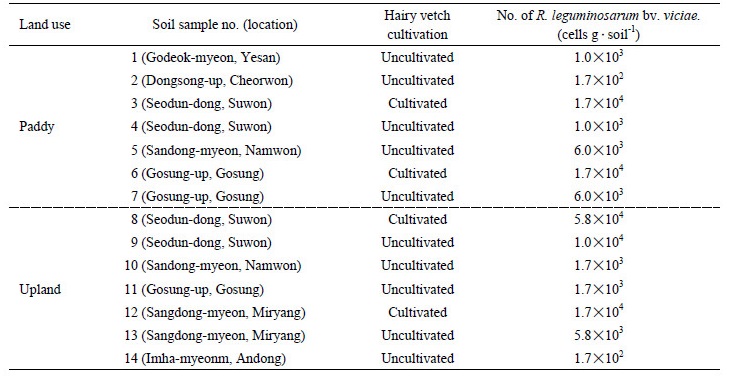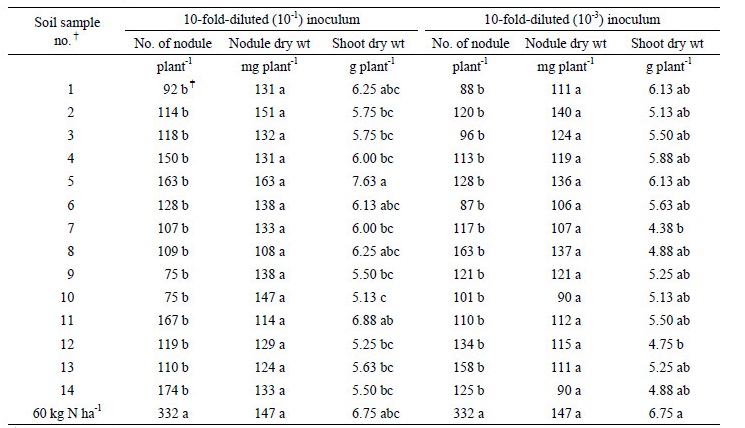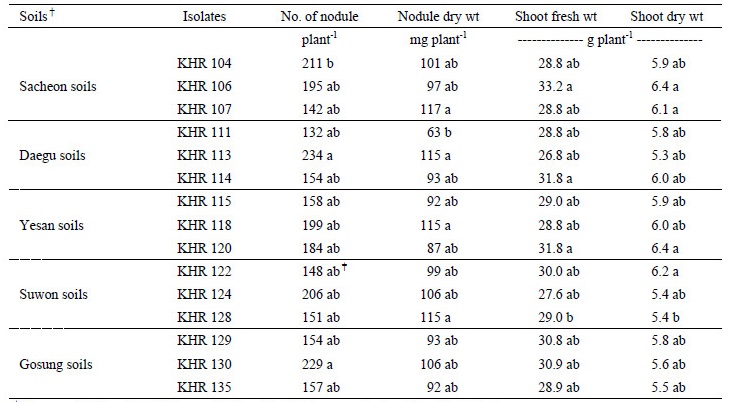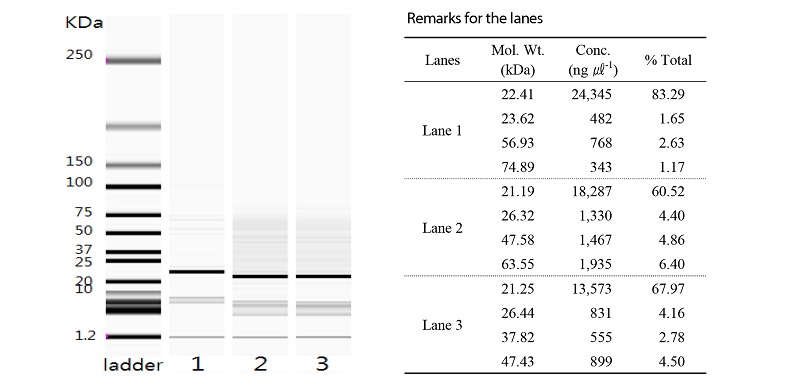Introduction
1900년대 풋거름용으로 도입된 (RDA, 2002) 헤어리베치 [hairy vetch (Vicia villosa Roth)]는 유럽과 서아시아가 원산지인데 (Undersander et al., 1990), 추위에 강하고 (Campiglia et al., 2010) 산성토양에서도 잘 자라 (Dastikaitė et al., 2009) 전 세계의 온대와 아열대지역에서 우수한 질소공급원으로 이용되고 있다 (USDA, 2016). 헤어리베치가 근류균 Rhizobium leguminosarum biovar viciae와의 공생관계를 가지면서 생산하는 질소량은 년간 58-257 kg N ha-1 범위인 것으로 알려져 있고 (Cherr et al., 2006; Parr et al., 2011; Wagger, 1989), 식물체의 C:N 구성비가 8:1-15:1 범위로 낮기 때문에 식물체 조직이 흙속에서 쉽게 분해되어 (USDA, 2016) 뒷그루작물에 필요한 질소를 생장초기부터 공급할 수 있는 장점을 지니고 있다 (Kang, 2007; Samson, 1990). 뿐만 아니라, 헤어리베치는 피복작물로 이용되어 토양의 침식을 줄이면서 (Lee et al., 2005; Maul et al., 2011) 잡초발생억제와 (Abdul-Baki and Teasdale, 2007; Choi et al., 2011; Mischler et al., 2010) 토양의 물리성 개선 및 수분증대 기능이 우수하여 (Clark et al., 1995; Jeon et al., 2011) 농업환경을 보전하면서 작물을 지속적으로 생산할 수 있는 지속농업이나 유기농업용 생물농자재로도 높이 평가된다 (Abdul-Baki and Teasdale, 2007; Maul et al., 2011; Rochester and Peoples, 2005; USDA, 2016). 이에 따라 헤어리베치의 생육에 중요한 공중질소 공급원인 질소고정근류균의 이용연구는 근류균의 생리, 유전성, 접종반응 등의 측면에서 다양하게 이루어지고 있는 추세이다 (Andrade et al., 2002; Chemining’wa and Vessey, 2006; Mothapo et al., 2013; Palmer and Young, 2000; Tumbure et al., 2013; Yuan et al., 2016). 그러나 우리나라에서의 헤어리베치 이용연구는 공생근류균인 R. leguminosarum bv. viciae (Laguerre et al., 2003)를 적극적으로 활용하기보다 헤어리베치의 토양피복효과와 농경지투입효과 위주로 수행되면서 (Choi et al., 2011; Jeon et al., 2011; Lee et al., 2005; Seo et al., 2000) 이를 위한 신품종까지 육성하기에 이르렀다 (Ku et al., 2014). 그러므로 우리나라의 지속농업 발전을 위한 생물농자재의 이용측면에서 볼 때, 헤어리베치 공생근류균 R. leguminosarum bv. viciae의 토착화 정도와 함께 토착화 된 균주의 헤어리베치 공생효과 등 헤어리베치-R. leguminosarum bv. viciae 공생관련 연구가 필요한 상황이다 (Ballard et al., 2004; Kang, 2007; Kang and Somasegaran et al., 1991; Kitou et al., 2010; Mothapo et al., 2013). 이에 따라 본 연구에서는 헤어리베치 공생근류균인 R. leguminosarum bv. viciae를 대상으로 우리나라 주요 논, 밭 토양에서의 서식밀도와 질소고정잠재능을 분석하고, 헤어리베치 증산에 이로울 것으로 예상되는 우수 균주를 선발하여 포장접종효과를 검토하였다.
Materials and Methods
시험용 농경지토양의 채취 헤어리베치 공생 근류균인 R. leguminosarum bv. viciae의 서식밀도와 질소고정잠재능 분석 그리고 공생효과 우수균주 분리를 위해서 전국의 주요 논토양 7곳과 밭 토양 7곳을 대상으로 표토를 2012년 3월에 채취하였다. 채취한 농가포장의 위치와 헤어리베치 재배여부에 따른 R. leguminosarum bv. viciae의 서식밀도는 Table 1과 같았다. R. leguminosarum bv. viciae의 밀도조사는 Kang and Somasegaran et al. (1991)의 방법에 따라 무균상태에서 발아시킨 ‘청풍보라’ (Ku et al., 2014) 유묘를 질소가 결재된 양액을 넣은 ‘growth pouch’에 1본 (plant)씩 치상한 다음, 멸균수로 10배부터 106배까지 희석한 토양시료 현탁액 1 mL씩을 4반복으로 접종하여 4주간 재배한 뒤 뿌리혹이 형성된 ‘growth pouch’의 개수로서 최확치법 (Most probable number method)으로 조사하였다 (Vincent, 1970). 그 결과 R. leguminosarum bv. viciae의 서식밀도는 논토양 (1.7✕102~1.7✕104 cells g ․ soil-1)보다 밭토양에서 (1.7✕102~5.8✕104 cells g ․ soil-1), 헤어리베치가 재배되지 않는 토양 (논, 1.7✕102~6.0✕103 cells g ․ soil-1; 밭, 1.7✕102~5.8✕103 cells g ․ soil-1)보다 재배되는 토양에서 (논, 1.7✕104 cells g ․ soil-1; 밭, 1.7✕104~5.8✕104 cells g ․ soil-1) 각각 더 높은 것으로 나타났다.
Table 1. Location and size of associated indigenous populations of R. leguminosarum bv. viciae of fourteen Korean soils.

농경지토양의 질소고정잠재능 분석 Table 1의 농경지에 분포한 R. leguminosarum bv. viciae의 질소고정잠재능 분석은 Kang (1998)과 Kang and Somasegaran et al. (1991)의 방법에 준했다. 먼저 질석을 넣은 1 L 들이 광구병에 무균상태로 발아시킨 헤어리베치 ‘청풍보라’의 유묘 2본을 치상한 다음, 작부처리 토양을 멸균증류수로 10배와 1000배 희석한 토양현탁액을 각각 1 mL씩 4반복으로 접종하여서 질소가 결재된 양액으로 개화기까지 6주간 재배한 후 헤어리베치의 지상부와 뿌리혹을 수확하였다. 이렇게 수확한 식물체와 뿌리혹 성적을 대상으로 해서 분석한 주요 농경지 서식 R. leguminosarum bv. viciae의 질소고정효과를 토양의 질소고정잠재능으로 평가하였다. 그리고 농경지토양 접종구의 대조구로 질소 6 kg 10a-1 시용구를 두어서 토양현탁액 대신 멸균증류수를 넣어 헤어리베치를 재배하였다.
헤어리베치 공생효과 우수 R. leguminosarum bv. viciae 선발 우수 R. leguminosarum bv. viciae 선발 대상 균주는 농경지토양의 질소고정잠재능 분석에서 헤어리베치 지상부의 건물무게가 높고 뿌리혹의 무게가 비교적 낮은 토양의 헤어리베치 뿌리혹과 (Table 3), 추가적으로 헤어리베치가 서식하고 있는 사천 곤명면 마곡리 밭토양과 대구 북구 금호강변 토양의 헤어리베치 뿌리혹을 각각 채취하여 Kang and Somasegaran et al. (1991)과 Vincent (1970)의 방법에 따라 YEM 배지 (Yeast extract 1g, Mannitol 10g, K2HPO40.5g, MgSO4 ․ 7H2O 0.2g, NaCl 0.2g, Fecl3 ․ 6H2O 2 mg, Agar 15 g, 증류수 1 L, pH 6.8-7.0) 위에서 토양단위별로 7균주씩 분리하였다. 분리한 균주는 Korean Hairy Rhizobium의 머리글자를 딴 KHR을 균주의 일련번호 앞에 붙여 명명하였다. 이들 균주의 헤어리베치 공생효과 시험은 15 cm (내경) ✕ 20 cm (높이)의 백색 Pot에 R. leguminosarum bv. viciae가 없는 질석을 600 g 담은 뒤 포장용수량의 물을 800 mL 넣었을 때의 Pot 내용물 무게인 1.4 kg을 기준으로 비료를 10 a 당 질소 (N) 3, 인산 (P2O5) 3, 칼리 (K2O) 3.4 kg 상당량 시용하여 4반복으로 추진하였다. 헤어리베치 재배는 ‘청풍보라’ 종자를 소독하여 무균상태에서 발아시킨 유묘를 Pot 당 4본씩을 이식하였다가 1주 후에 건전한 것 2본씩만 남겨 재배하였다. 분리한 R. leguminosarum bv. viciae 균주의 접종은 한천을 뺀 YEM 배지에서 균주를 108 cells 수준으로 진탕배양한 후 헤어리베치 유묘 개체 당 1 mL씩 접종실시하였다. 재배한 헤어리베치는 개화기에 수확하여 지상부 생육량과 함께 지하부 뿌리혹의 수와 무게 성적을 종합적으로 검토해서 공생효과가 우수한 R. leguminosarum bv. viciae를 선발하였다.
Table 2. Physicochemical properties of upland soils used for hairy vetch cultivation by Korean R. leguminosarum bv. viciae isolates.

† See foot notes to Table 1.
‡ Numbers followed by the same letter within a column are not significantly different (Duncan test, p < 0.05).
Table 3. Symbiotic potentials of native Korean R. leguminosarum bv. viciae populations in whole-soil inoculum inoculated on Hairy vetch.

R. leguminosarum bv. viciae의 헤어리베치 접종효과 포장시험 Pot 시험에서 헤어리베치와의 공생효과가 우수한 R. leguminosarum bv. viciae 균주 2종을 대상으로 한 포장접종시험은 경북 상주의 해발 285 m에 위치한 국립식량과학원 상주출장소 밭 포장에서 실시하였으며 시험된 밭토양의 이화학적 특성은 Table 2와 같았다. 시험토양은 양토였고 pH가 약 알칼리성을 띠었으며 유기물은 적정수준이었으나 유효인산과 치환성 칼리, 칼슘, 마그네슘이 적정수준보다 높은 경향이었다. 그리고 시험지에는 R. leguminosarum bv. viciae가 토양 1 g 당 5.8✕10cells 서식하고 있었다. R. leguminosarum bv. viciae 균주의 접종은 250 mL 삼각플라스크 속에 과산화수소수로 멸균 처리한 헤어리베치 ‘청풍보라’ 종자 60 g을 넣고, 한천을 뺀 YEM조성물의 액체배지에서 mL 당 333✕107 cells 농도로 배양한 균주 배양액 7 mL를 그 종자 위에 마이크로피펫으로 조금씩 떨어뜨리면서 역시 멸균 처리한 질석가루 (200 mesh 크기) 5 g도 소량씩 넣어 손으로 플라스크를 세게 돌리는 방법으로 종자에 코팅 접종하였다. 접종된 헤어리베치 종자는 플라스크 속에 남아있는 질석과 함께 2✕5 m2크기의 시험구에 흩어 뿌리고 흙으로 코팅된 종자가 보이지 않게 덮어 주었다. 시험구는 우수균주 2종을 각각 단독으로 접종 처리한 2개 구와 혼합접종 처리한 1개 구, 그리고 대조구로서 균주배양액 대신 멸균 증류수로 질석을 종자에 코팅하여 처리한 1개 구로 구성된 총 4개 처리구를 두어서 단구제로 시험하였다. 시험된 헤어리베치는 일체의 비료를 주지 않고 개화기까지 75일간 재배하여 수확하였다.
R. leguminosarum bv. viciae의 단백질 전기영동분석 헤어리베치에 대해서 공생효과가 우수한 R. leguminosarum bv. viciae 균주의 동질성을 구분하기 위해 (Kang et al., 1996) 시도한 단백질 전기영동분석은 Experion Pro260 (Bio-Rad, Hercules, CA) 분석키트를 사용하였다. 먼저 균주를 YMB 배지에서 108 cells mL-1 이상으로 배양한 배양액 5 mL를 12,000 rpm 조건으로 10분간 원심분리한 후 침전물에 10 mM tris-HCl 5 mL을 가하여 같은 조건으로 다시 원심분리한 다음, 침전물에 LDS sample buffer와 10 mM tris-HCl의 1:1 혼합액 0.2 mL에 현탁시켜 3분간 끓이고 이것을 얼음상자에 보관하면서 30초간 Vortex 처리하여 전기영동하였다. 그리고 단백질의 분자량 규명을 위해서 분자량 10~250 kDa 범위의 recombinant proteins을 포함한 Experion Pro260 ladder를 사용하였다.
통계분석 SAS 프로그램 9.1.3 버전 (2006)으로 시험 성적을 상관분석과 분산분석 하였다.
Results
농경지토양의 질소고정잠재능 우리나라 남부의 경남 고성에서부터 중부의 강원도 철원에 이르기까지 주요지역 논토양과 밭토양의 (Table 1) 질소고정잠재능은 Table 3과 같았다. 헤어리베치의 초장과 근류수, 근류무게는 시험토양을 10배 희석하여 접종했을 때와 1000배 희석해서 접종했을 때 모두 토양 간에 유의적인 차이가 없었다. 헤어리베치의 건물량은 토양을 10배 희석접종한 경우 가장 높은 토양이 남원의 논토양이었고 (p < 0.05) 두 번째는 고성의 밭토양이었으며 가장 낮은 토양은 남원의 밭토양이었는데, 남원 논토양과 고성 밭토양의 성적은 질소비료를 요소로 ha 당 60 kg 시용했을 때의 성적보다 더 높았다. 토양을 1000배 희석접종했을 때의 헤어리베치 건물량은 서로 유의적인 차이가 없는 고성의 논토양과 밀양의 밭토양을 제외한 모든 토양이 이들 두 토양보다 높았다. 1000배 희석접종 토양 중에서 헤어리베치 건물량의 절대치는 헤어리베치를 재배하지는 않지만 R. leguminosarum bv. viciae의 서식밀도가 토양 1g 당 6.0✕103 cells 수준인 예산 논토양과 6.0✕103 cells 수준인 남원의 논토양이 다 같이 가장 높았는데, 이들 토양이 보인 성적은 헤어리베치가 재배되면서 R. leguminosarum bv. viciae의 서식밀도가 5.8✕104 cells 수준으로 높았던 수원의 밭토양과 1.7✕104 cells 수준인 수원과 고성의 논토양 및 밀양의 밭토양보다도 높았다. 그런데 토양별로 R. leguminosarum bv. viciae 균주들의 헤어리베치 공생효과 정도를 파악하기 위해 헤어리베치의 건물량 값을 뿌리혹무게 값으로 나눠서 본 결과 (Kang and Somasegaran et al., 1991), 공생효과가 우수한 균주를 내포한 토양 3곳은 10배 희석접종과 1000배 희석접종한 성적을 볼 때 헤어리베치가 자라는 고성 논토양 (10배 희석접종 44.4; 1000배 희석접종 53.1), 헤어리베치를 재배하지 않는 예산 논토양 (10배 희석접종 47.8; 1000배 희석접종 55.2)과 수원 논토양 (10배 희석접종 45.8; 1000배 희석접종 49.4)으로 압축할 수 있었다.
헤어리베치 공생효과 우수 R. leguminosarum bv. viciae 선발 Table 3에서 질소고정잠재능이 우수한 것으로 확인된 예산, 수원, 고성의 논토양에서 분리한 R. leguminosarum bv. viciae 각 7균주와 사천의 밭토양과 대구 금호강변 토양에 자생하는 헤어리베치의 뿌리혹에서 분리한 R. leguminosarum bv. viciae 각 7균주 중에서 토양단위별로 헤어리베치 공생효과가 우수한 상위 3균주를 선별하여 정리한 성적은 Table 4와 같았다. 이들 가운데 뿌리혹 수는 대구의 KHR 113, 고성의 KHR 130 접종구에서 가장 높았고 (p < 0.05), 뿌리혹 무게는 사천의 KHR 107, 대구의 KHR 113, 수원의 KHR 128 접종구에서 가장 높게 나타났다 (p < 0.05). 그리고 헤어리베치의 건물생산에 가장 큰 기여를 한 (p < 0.05) 전체토양의 상위 3균주는 사천의 KHR 106 (6.4 g plant-1 생산), 예산의 KHR 120 (6.4 g plant-1 생산), 수원의 KHR 122 (6.2 g plant-1 생산)이었다. 이를 토대로 해서 분석한 뿌리혹무게 대비 헤어리베치의 건물생산량 값, 즉 공생효과가 우수한 균주 2종은 헤어리베치를 재배하고 있는 사천 곤명면 마곡리의 KHR 106 (66.0)과 헤어리베치를 재배하지 않는 예산 고덕면 사리의 논토양에 분포한 KHR 120 (73.6)이었다.
Table 4. Effect of some Korean isolates of R. leguminosarum bv. viciae on the growth and root nodule development of hairy vetch in pot.

† Suwon soils from No. 4; Yesan soils from No. 1; Gosung soils from No. 6 in Table 1.
‡ Numbers followed by the same letter within a column are not significantly different (Duncan test, p < 0.05).
R. leguminosarum bv. viciae 균주의 헤어리베치 접종효과 Table 4의 Pot시험에서 공생효과 우수균주로 선발된 R. leguminosarum bv. viciae KHR 106과 KHR 120의 포장시험 결과는 Table 5와 같았다. 단독 접종한 헤어리베치의 건물 생산량은 Table 4의 성적과 마찬가지로 KHR 106 균주와 KHR 120 균주 간에 유의적인 차이가 없었지만 각각 5.19 t ha-1과 5.18 t ha-1으로 나타났다. 그러나 이들의 값은 무접종구의 것보다 유의적으로 높았다 (p < 0.05). 균주를 혼합 접종한 헤어리베치는 건물생산량이 단독접종 성적의 95% 수준으로 낮았으나 무접종구의 헤어리베치보다는 11% 증수되었고, 다른 처리구와 유의적인 차이를 보이지 않았다.
Table 5. Shoot yields of hairy vetch inoculated with Korean R. leguminosarum bv. viciae isolates in upland soils.

R. leguminosarum bv. viciae의 단백질 전기영동 양상 Table 4에서 헤어리베치의 건물생산량이 높았던 R. leguminosarum bv. viciae KHR 106, KHR 120, KHR 122의 3균주에 대해서 단백질 전기영동을 한 결과는 Fig. 1과 같았다. 단백질의 분자량 분포는 사천 곤명면 마곡리의 KHR 106 균주 (Lane 1)의 경우 22.41 kDa의 단백질이 83.3% 이었고, 예산 고덕면 사리의 KHR 120 균주 (Lane 2)는 21.19 kDa의 것이 60.5% 이었으며, 수원 서둔동의 KHR 122 균주 (Lane 3)는 21.25 kDa의 것이 68.0% 이었다. 그러므로 이들 3균주는 단백질의 특성 측면에서 서로 다른 균주임을 알 수 있었다.
Discussion
일반적으로 콩과식물의 생육은 공생관계를 갖는 질소고정 근류균의 토양서식 정도와 (Kang and Somasegaran et al., 1991; Kang et al., 1992), 숙주뿌리 감염 (Kang and Somasegaran et al., 1991; Lima et al., 2009) 그리고 질소고정력의 발현 정도에 (Chemining’wa and Vessey, 2006; Kang et al., 1991; Kitou et al., 2010; Yuan et al., 2016) 영향을 받는다. 본 시험에서 조사된 R. leguminosarum bv. viciae의 서식 밀도는 밭토양이 논토양보다 헤어리베치 재배지에서 10%, 무재배지에서는 37% 가량 더 높았다 (Table 1). 토양의 질소고정잠재능으로 본 헤어리베치 건물생산량은 이와 반대로 10배 희석한 토양을 접종했을 때 논토양이 밭토양보다 11.2% 높았고 1000배 희석접종했을 때는 8.8% 더 높았다 (Table 3). 이렇게 논토양의 R. leguminosarum bv. viciae 균주들이 밭토양 균주보다 수적으로 약간 열세에도 불구하고 높은 헤어리베치 건물생산량을 보인 것은 그만큼 질소고정력이 우수한 균주가 많음을 뜻하는 것으로 해석되었다 (Kang, 1998; Kang and Somasegaran et al., 1991). 그리고 Table 3의 질소고정잠재능 성적을 바탕으로 하여 예산과 수원, 고성의 논토양에서 분리한 R. leguminosarum bv. viciae 균주들의 헤어리베치 건물생산량 평균값은 (Table 4) 각각 6.1 g plant-1, 5.7 g plant-1, 5.6 g plant-1 으로 계산되었는데, 이러한 순위경향은 Table 3의 10배 희석토양의 접종구 건물성적경향과 일치하였다. 토양별 최고 건물생산량 역시 예산 6.4 g plant-1 (KHR 120 균주), 수원 6.2 g plant-1 (KHR 122 균주), 고성 5.8 g plant-1 (KHR 129 균주)으로서 이들과 마찬가지 경향을 보였다. 이런 점에서 토양을 희석접종해서 근류균의 공생효과를 알아보는 질소고정잠재능 시험은 우수균주의 보유정도를 나타내는 기준이 될 수 있음을 확인할 수 있었다 (Kang and Somasegaran et al., 1991).
보고에 의하면 (Kang and Somasegaran et al., 1991; Mothapo et al., 2013) 근류균의 서식밀도는 숙주식물의 재배에 영향을 받는 경향인데, 우리나라 콩 근류균 Bradyrhizobium japonicum의 농경지 서식경향을 (Kang, 1998) 참고할 때 R. leguminosarum bv. viciae가 논토양에서보다 밭토양에 많이 분포한 것은 (Table 1) 숙주식물인 헤어리베치가 국내에 도입된 이후 물에 잠기지 않는 밭토양 주변에서 쉽게 증식할 수 있었기 때문이 아닌가 생각되었다. 그런데 밭토양에 서식한 R. leguminosarum bv. viciae 균주보다 최근에 헤어리베치를 재배하지 않았고 R. leguminosarum bv. viciae 밀도가 1.0✕103 cells g ․ soil-1 수준으로 낮은 예산과 수원의 논토양은 헤어리베치의 건물생산을 증가시킨 균주를 많이 포함한 경향이었는데 (Table 3, 4), 이는 Bradyrhizobium japonicum 밀도가 높은 토양에서 콩의 건물생산량이 많았다고 한 강 (1998)의 보고와 달랐으며 서식하고 있는 R. leguminosarum bv. viciae의 다양성 측면에서도 헤어리베치의 재배품종 (Mothapo et al., 2013), 재배 작부 (Depret et al., 2004; Grossman et al., 2011), 무경운 재배 여부 (Kaschuk et al., 2006), R. leguminosarum bv. viciae 접종재배 여부 (de Fatima et al., 2007) 등에 대한 검토의 여지가 있음을 뜻하는 것으로 판단되었다. 한편, Table 1의 철원 동송읍 논토양과 안동 임하면의 밭토양에서는 R. leguminosarum bv. viciae의 서식밀도가 최확치법으로 1.7✕102 cells g ․ soil-1 수준이었는데도 이들 토양을 1000배 희석접종한 헤어리베치에서 뿌리혹이 다수 발견되었다 (Table 3). 이러한 결과는 Kang and Somasegaran et al. (1991)의 시험에서도 확인되었는데, 질소고정 잠재능시험 과정에서의 먼지오염 또는 ‘Growth pouch’를 이용한 최확치법의 분석한계 (Turk and Keyser, 1993; Woomer et al., 1988) 때문이 아닌가 생각되었다. 그리고 Table 4에서 헤어리베치 공생효과가 우수한 균주로 확인된 R. leguminosarum bv. viciae KHR 106과 KHR 120, KHR 122는 단백질 전기영동에서 서로 다른 류형을 보였는데 (Fig. 1), 이러한 현상은 헤어리베치의 재배역사에서 R. leguminosarum bv. viciae 접종여부는 알 수 없지만 이들 균주가 Bradyrhizobium japonicum 처럼 우리나라에 토착화 되는 과정에 다양화 된 결과로 해석되었다. 특히 설득력을 얻는 것은 아마도 다양한 헤어리베치 품종의 도입재배 가능성이었다. Mothapo et al. (2013)은 다양한 헤어리베치 품종을 재배하면 근류균의 유전적 다양성이 높아진다고 하였고, Zhang et al. (2001)은 토착화 된 R. leguminosarum bv. viciae 균주는 숙주식물이 없어도 서로간에 유전자 이동이 일어나면서 다양해진다고 하였다. Yuan et al. (2016)은 토착 R. leguminosarum bv. viciae가 다양하게 분포하는 일본에서 R. leguminosarum bv. viciae의 헤어리베치 접종효과를 확인하였는데, 본 시험에서도 선발한 KHR 106 균주와 KHR 120 균주를 토착 R. leguminosarum bv. viciae가 5.8✕10 cells g ․ soil-1 서식하는 토양에서 헤어리베치 에 접종하여 16%의 유의적인 헤어리베치 증수효과를 확인할 수 있었다. 그러나 두 균주를 혼합해서 접종했을 때는 헤어리베치의 건물생산량이 증가되는 효과는 있었지만 단독접종한 것보다 뒤졌고 관행의 접종하지 않은 것에 비해서도 유의적인 차이를 보이지 않았다. 그러므로 질소성분이 높은 풋거름 생산효과가 우수한 헤어리베치의 안정적인 증산을 위해서는 유전형질이 다양한 재배예정지 토착근류균과의 근류형성 경합력이 높으면서 상가적인 공생효과를 기대할 수 있는 질소고정력이 우수한 R. leguminosarum bv. viciae 균주들을 이용하는 것이 바람직 할 것으로 판된되었다 (Ballard et al., 2004; Chemining’wa et al., 2006; Kang and Somasegaran et al., 1991; Lima et al., 2009).
Conclusions
우리나라에서 풋거름 작물인 헤어리베치를 재배할 때 질소고정 근류균 Rhizobium leguminosarum biovar viciae의 활용 가능성을 검토할 목적으로 농경지에 분포하는 토착 R. leguminosarum biovar viciae의 몇 가지 특성을 분석한 결과는 다음과 같다. R. leguminosarum biovar viciae의 서식밀도는 논토양 7곳에 1.7✕102~1.7✕104 cells g ․ soil-1, 밭토양 7곳에서는 1.7✕102~5.8✕104 cells g ․ soil-1로 밭에서 논보다 10% (헤어리베치 재배지)~37% (헤어리베치 무재배지) 가량 더 높았다. 그러나 토양을 10배와 1000배 희석해서 접종한 헤어리베치의 건물생산량은 논토양이 밭토양보다 각각 11.2%, 8.8% 더 높았다. 토양에서 분리한 R. leguminosarum biovar viciae 균주 가운데 경남 사천시 곤명면 마곡리의 KHR 106과 충남 예산군 고덕면 사리의 KHR 120을 접종한 헤어리베치는 토착 R. leguminosarum biovar viciae가 5.8✕10cells g ․ soil-1 서식하는 밭에서 각각 5.19 t ha-1과 5.18 t ha-1의 건물생산량을 보이면서 16% 증수되었다 (p < 0.05). 그러나 이들을 혼합 접종한 헤어리베치의 건물생산량은 단독 접종한 경우보다 유의적인 차이 없이 5% 가량 낮았다. 그리고 KHR 106 균주는 22.41 kDa의 분자량을 가진 단백질이 전체 단백질의 83.3%, KHR 120 균주는 21.19 kDa의 것이 60.5% 이었으며, 이들보다 공생효과가 낮은 수원 서둔동의 KHR 122 균주는 21.25 kDa의 것이 68.0% 이었다. 이상의 결과로 볼 때, 우리나라 농경지에서 헤어리베치를 재배할 경우 다양한 토착 R. leguminosarum biovar viciae 에 의한 공중질소 공급효과가 기대되지만, 보다 좋은 생육을 위해서는 질소고정력이 높고 근류형성 경합력이 우수한 균주의 접종이용이 바람직할 것으로 판단되었다.






